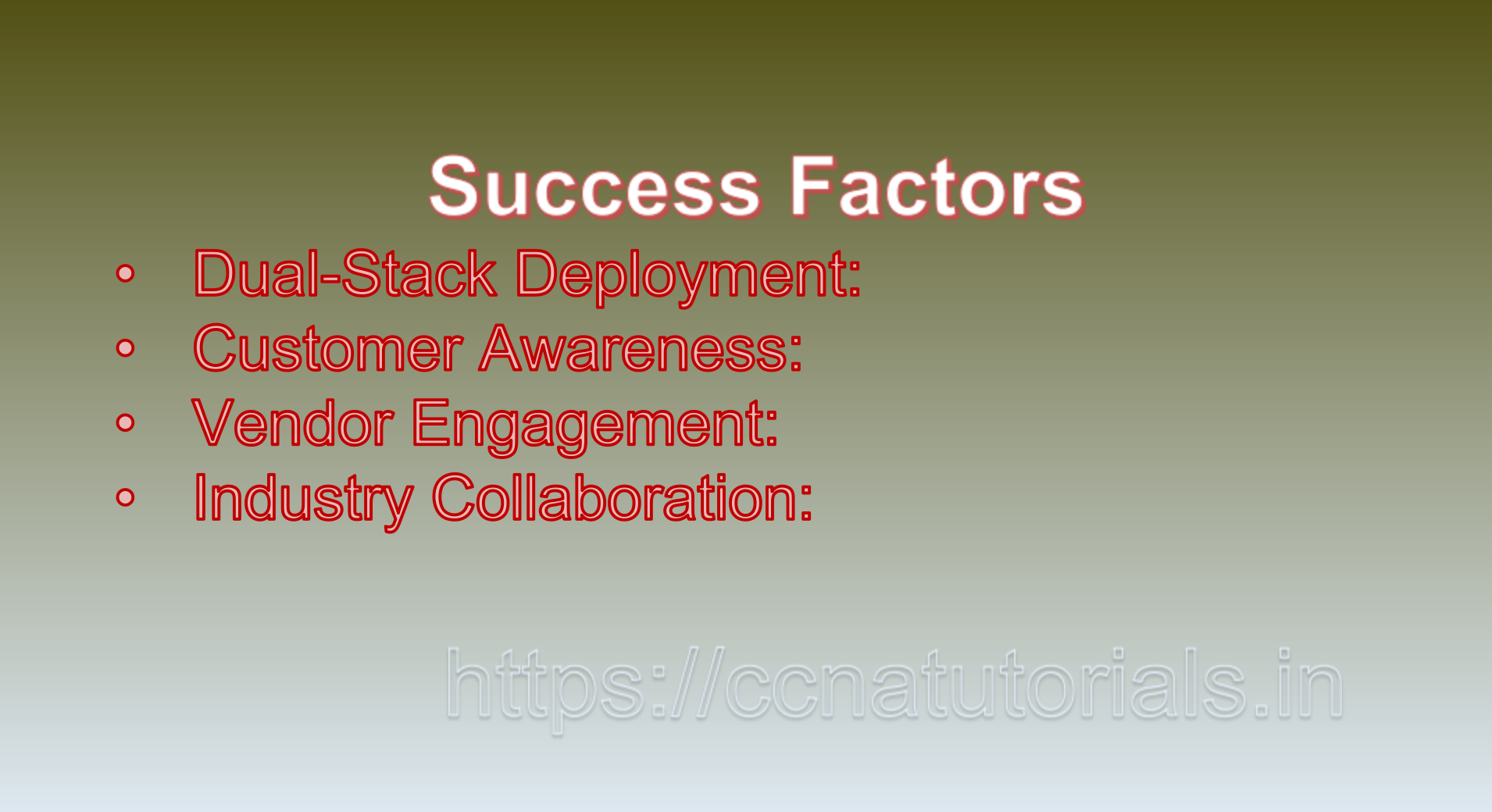Contents of this article
In this article, I describe IPv6 Case Studies and Success Stories, Pioneering the Future of Networking. As the world grapples with the limitations of IPv4 addresses, the adoption of IPv6 (Internet Protocol version 6) has gained momentum. IPv6 offers a vast address space and improved features to accommodate the growing number of connected devices. This article delves into real-world IPv6 case studies and success stories, highlighting how organizations and regions have successfully embraced IPv6 to overcome challenges, enhance connectivity, and foster innovation.
Case Study 1: Comcast – Leading IPv6 Adoption in the United States
Comcast, one of the largest broadband providers in the United States, embarked on an ambitious journey to transition to IPv6. With the proliferation of devices and the need to provide internet services to an ever-expanding customer base, IPv4’s address limitations posed a significant challenge.
Success Factors:
1. Dual-Stack Deployment:
Comcast adopted a dual-stack approach, allowing both IPv4 and IPv6 traffic to coexist on their network. This enabled a gradual transition without disrupting existing services.
2. Customer Awareness:
Comcast actively educated its customers about the benefits of IPv6 and the impending exhaustion of IPv4 addresses. This awareness campaign encouraged customer support for the transition.
3. Vendor Engagement:
Comcast collaborated with network equipment vendors to ensure that the hardware and software used were IPv6 compatible.
4. Industry Collaboration:
Comcast participated in industry initiatives and forums dedicated to IPv6 adoption. This collaborative approach facilitated knowledge sharing and best practice development.
The result of Comcast’s efforts was a successful transition to IPv6, positioning the company as a leader in IPv6 adoption in the United States. This case study showcases the importance of collaboration, customer education, and gradual deployment strategies.
Case Study 2: RIPE NCC – Promoting IPv6 Adoption in Europe
RIPE NCC (Réseaux IP Européens Network Coordination Centre) is one of the five Regional Internet Registries (RIRs) responsible for managing IP address distribution in Europe, the Middle East, and parts of Central Asia. Recognizing the need for a smooth transition to IPv6, RIPE NCC played a pivotal role in promoting IPv6 adoption across its region.
Success Factors:
1. IPv6 Training and Workshops:
RIPE NCC organized workshops, webinars, and training sessions to educate network administrators, engineers, and businesses about IPv6’s technical aspects and benefits.
2. IPv6 Roadshows:
The organization conducted IPv6 roadshows across its service region, bringing together experts, policymakers, and stakeholders to share knowledge and experiences.
3. IPv6 Deployment Assistance:
RIPE NCC provided technical support and resources to network operators and businesses embarking on their IPv6 journey. This assistance eased the implementation process for organizations.
4. Policy Development:
RIPE NCC collaborated with its community to develop IPv6-related policies, ensuring that the necessary regulatory frameworks were in place to facilitate adoption.
By fostering awareness, providing resources, and encouraging policy development, RIPE NCC contributed significantly to the widespread adoption of IPv6 in Europe. This case study underscores the importance of educational initiatives and support structures.
Case Study 3: Japan – Advancing IPv6 for a Connected Society
Japan stands as a notable example of a nation embracing IPv6 as a cornerstone of its technological advancement strategy. With the rise of IoT, smart cities, and innovative applications, Japan recognized the need for an address protocol that could accommodate the proliferation of connected devices.
Success Factors:
1. Government Leadership:
The Japanese government actively promoted IPv6 adoption by establishing policies that required government agencies and public services to transition to IPv6.
2. Collaboration with Industry:
Japanese telecommunications companies, along with government agencies, collaborated to ensure IPv6 support in network infrastructure and consumer devices.
3. IoT and Smart City Initiatives:
As part of its “Society 5.0” vision, Japan integrated IPv6 into its smart city projects, enabling seamless communication between devices and services.
4. Global Engagement:
Japan participated in international forums and collaborations to share its IPv6 experiences and learn from other nations’ successes.
Japan’s comprehensive approach to IPv6 adoption, driven by government initiatives and industry collaboration, has positioned the country as a leader in leveraging IPv6 for technological innovation.

In short IPv6 Case Studies and Success Stories:
These IPv6 case studies and success stories highlight the transformative impact of IPv6 adoption across various sectors. Organizations, governments, and regions have recognized the need for a robust and scalable addressing protocol to fuel their digital ambitions. By implementing strategies such as dual-stack deployment, customer education, technical support, policy development, and industry collaboration, these entities have overcome challenges and reaped the benefits of IPv6.
As the global internet landscape evolves, IPv6 adoption continues to be a critical enabler of connectivity, security, and innovation. The lessons learned from these case studies serve as valuable insights for other organizations and regions that are navigating their own IPv6 adoption journeys. With IPv6 as the foundation, we are witnessing the realization of a more interconnected, efficient, and dynamic digital future.
IPv6 Case Studies and Success Stories in another terms
As the internet continues to evolve, the transition to Internet Protocol version 6 (IPv6) has become essential to address the limitations of the older IPv4 protocol. IPv6 offers a larger address space, improved security, and support for the growing number of connected devices. In various sectors and regions, organizations have successfully implemented IPv6, demonstrating its potential to drive innovation, enhance security, and ensure future connectivity. This article presents a series of IPv6 case studies and success stories, showcasing the real-world impact of IPv6 adoption across different contexts.
1. Comcast: Enabling Massive Connectivity
Comcast, one of the largest cable and internet service providers in the United States, embarked on an ambitious journey to transition its network infrastructure to IPv6. Facing the depletion of available IPv4 addresses, Comcast recognized the need to future-proof its services.
Success Factors:
– Dual-Stack Deployment: Comcast employed a dual-stack approach, enabling both IPv4 and IPv6 on its network. This approach allowed seamless communication with legacy IPv4 devices while paving the way for IPv6 adoption.
– Collaboration: Comcast worked closely with vendors, industry partners, and internet registries to ensure compatibility and interoperability of its IPv6 implementation.
– Gradual Migration: The company took a phased approach, migrating different components of its network over time. This strategy minimized disruptions and ensured a smooth transition.
Impact:
Comcast’s IPv6 deployment enabled the company to accommodate the growing number of internet-connected devices. It improved the user experience by eliminating the need for network address translation (NAT) and allowed Comcast to continue offering innovative services to its customers.
2. RIPE NCC: Facilitating Regional Adoption
The Réseaux IP Européens Network Coordination Centre (RIPE NCC) is responsible for managing IP address allocation and registration in Europe, the Middle East, and parts of Central Asia. RIPE NCC played a vital role in promoting and supporting IPv6 adoption across its region.
Success Factors:
– IPv6 Training and Support: RIPE NCC provided training sessions, workshops, and resources to help network administrators and organizations understand and implement IPv6 effectively.
– IPv6 Readiness Survey: RIPE NCC conducted surveys to assess the readiness of network operators for IPv6 adoption. The survey results informed the development of targeted initiatives and resources.
– Encouraging IPv6-Only Networks: RIPE NCC encouraged the establishment of IPv6-only networks to showcase the feasibility and benefits of IPv6 without relying on IPv4.
Impact:
RIPE NCC’s efforts significantly contributed to the increase in IPv6 adoption within its service region. By providing educational resources and support, RIPE NCC empowered network administrators to make informed decisions about IPv6 implementation, ultimately enhancing regional connectivity.
3. Japanese Government: Leading the Way for the Public Sector
The Japanese government recognized the importance of IPv6 in realizing its vision of a hyper-connected society. To support this vision, the government took proactive steps to promote IPv6 adoption across its various agencies.
Success Factors:
– IPv6-Ready Certification: The Japanese government established an IPv6-Ready certification program to encourage the development and deployment of IPv6-compatible products and services.
– Legislation and Policy: The government introduced policies that required government agencies to make their websites and online services accessible via IPv6. This mandate spurred IPv6 adoption within the public sector.
– Collaboration with Industry: The government collaborated with private sector stakeholders, including ISPs and technology companies, to create a conducive environment for IPv6 adoption.
Impact:
Japan’s commitment to IPv6 adoption has positioned the country as a leader in the development of next-generation internet infrastructure. By requiring government agencies to adopt IPv6, the government played a pivotal role in raising awareness and accelerating the deployment of IPv6 within its borders.
4. Google: Embracing IPv6 as a Global Technology Giant
Google, one of the world’s largest technology companies, recognized the importance of IPv6 in sustaining the growth of the internet and its services. Google’s commitment to IPv6 adoption set an example for other technology giants.
Success Factors:
– IPv6 by Default: Google made its services IPv6-ready by default. This approach ensured that users with IPv6-capable networks could seamlessly access Google’s services over IPv6.
– Measurement and Reporting: Google actively measured and reported its progress in adopting IPv6. This transparency not only showcased Google’s commitment but also encouraged other organizations to follow suit.
– Public Advocacy: Google advocated for IPv6 adoption through blog posts, technical resources, and presentations at industry events. This advocacy helped raise awareness about IPv6’s benefits and motivated other organizations to take action.
Impact:
Google’s widespread adoption of IPv6 contributed to the overall growth of IPv6 traffic on the internet. By making its services accessible over IPv6, Google improved the user experience for IPv6-enabled networks and demonstrated the feasibility of large-scale IPv6 deployment.
Conclusion for IPv6 Case Studies and Success Stories
These IPv6 case studies and success stories highlight the transformative power of IPv6 adoption across various sectors and regions. From internet service providers to governments and technology giants, organizations have realized the benefits of IPv6 in terms of scalability, security, and future readiness. These success stories underscore the importance of collaboration, education, and a strategic approach to implementation. As more organizations transition to IPv6, the global internet ecosystem becomes more interconnected and resilient, paving the way for a digital future that is fully prepared to accommodate the demands of a rapidly evolving technological landscape.






